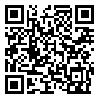Volume 22 - Supplement 1
Iran South Med J 2019, 22 - Supplement 1: 0-0 |
Back to browse issues page
Download citation:
BibTeX | RIS | EndNote | Medlars | ProCite | Reference Manager | RefWorks
Send citation to:



BibTeX | RIS | EndNote | Medlars | ProCite | Reference Manager | RefWorks
Send citation to:
Pahlavan- Sharif M, Abassi M. Comparative Study of Jaundice Treatment in Traditional Medicine of Iran, in Some Areas of South and North. Iran South Med J 2019; 22
URL: http://ismj.bpums.ac.ir/article-1-1060-en.html
URL: http://ismj.bpums.ac.ir/article-1-1060-en.html
1- Institute of Anthropology, Cultural Heritage and Tourism Research Institute, Tehran, Iran , a_maryam1983@yahoo.com
2- Institute of Anthropology, Cultural Heritage and Tourism Research Institute, Tehran, Iran
2- Institute of Anthropology, Cultural Heritage and Tourism Research Institute, Tehran, Iran
Abstract: (10222 Views)
Background: Icterus / Jaundice is a type of gastrointestinal and abdominal disorder that is associated with a change in color and yellowish of the patient's skin and eyes. In terms of traditional Iranian medicine, jaundice is a liver dysfunction and a type of biliary atashi disease, which ancient physicians described as a yellowish or black coloration of the body. The disease is treated among different ethnic groups in Iran in various traditional ways (both herbal and non- herbal). The purpose of this study was to find out the therapeutic methods of Icterus disease that has been used in the northern and southern regions of Iran (West Azarbaijan and Hormozgan). The research also seeks to examine the traditional way of treating the disease in the two mentioned regions using fieldwork and documentation methods in a comparative perspective.
Materials and Methods: The data of the present research is the result of anthropological researches based on fieldwork (in-depth interview and observation technique) and documentary based and library research methods. To collect these data, all of the field study, documentary based and library research methods have been used. Interview with the fishermen as indigenous people has been one of these methods.
Results: Since ancient times, traditional treatment of diseases has been one of the most well-known methods of treatment in different ethnic cultures. Considering the extent, richness and cultural-ethnic diversity of Iran, treatment with this method has a special place. In general, along with the use of various medicinal species such as jaru, yellow Watermelon, bulagh uti, camel's thorn fruit and some other herbal species, methods such as scarifying, using a yellow bead, cauterizing, giving the patient live fish, using mineral water, and use of certain products derived from several types of fish (Gin, Parrot fish etc.) as tan shuye (body cleaner), were considered the most common treatments for jaundice in both regions.
Conclusion: A wide variety of therapeutic methods, herbs (botanical / herbal medicine), marine products and healing rituals has been recorded in both geographic regions. Various methods found in traditional medicine of a region are also found in other areas with many similarities. A study on traditional medicine can identify these methods, exchanges and cultural effects among people living in the region and elsewhere.
Materials and Methods: The data of the present research is the result of anthropological researches based on fieldwork (in-depth interview and observation technique) and documentary based and library research methods. To collect these data, all of the field study, documentary based and library research methods have been used. Interview with the fishermen as indigenous people has been one of these methods.
Results: Since ancient times, traditional treatment of diseases has been one of the most well-known methods of treatment in different ethnic cultures. Considering the extent, richness and cultural-ethnic diversity of Iran, treatment with this method has a special place. In general, along with the use of various medicinal species such as jaru, yellow Watermelon, bulagh uti, camel's thorn fruit and some other herbal species, methods such as scarifying, using a yellow bead, cauterizing, giving the patient live fish, using mineral water, and use of certain products derived from several types of fish (Gin, Parrot fish etc.) as tan shuye (body cleaner), were considered the most common treatments for jaundice in both regions.
Conclusion: A wide variety of therapeutic methods, herbs (botanical / herbal medicine), marine products and healing rituals has been recorded in both geographic regions. Various methods found in traditional medicine of a region are also found in other areas with many similarities. A study on traditional medicine can identify these methods, exchanges and cultural effects among people living in the region and elsewhere.
Keywords: Jaundice Disease, Traditional treatment, Indigenous Knowledge, West Azarbaijan, Hormozgan, Plant
Type of Study: Original |
Subject:
General
Received: 2019/05/7 | Accepted: 2019/05/7 | Published: 2019/05/7
Received: 2019/05/7 | Accepted: 2019/05/7 | Published: 2019/05/7
Send email to the article author
| Rights and Permissions | |
 |
This work is licensed under a Creative Commons Attribution-NonCommercial 4.0 International License. |






